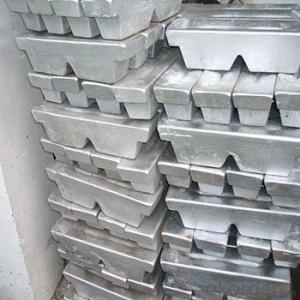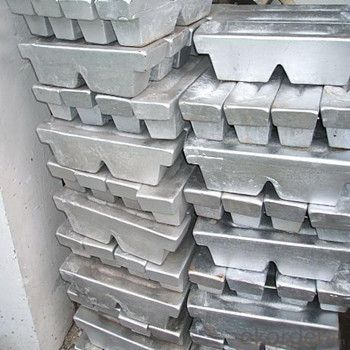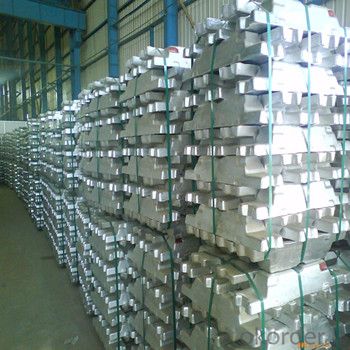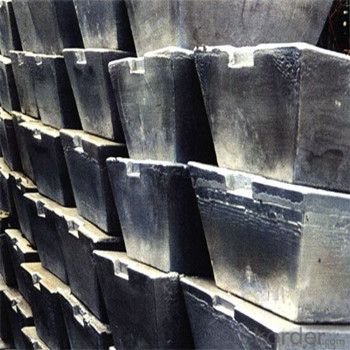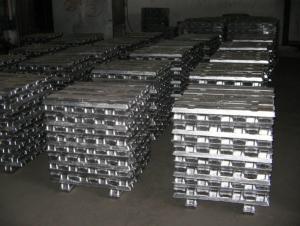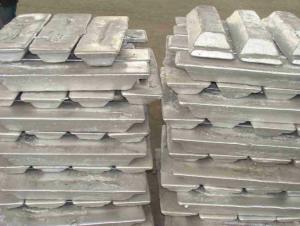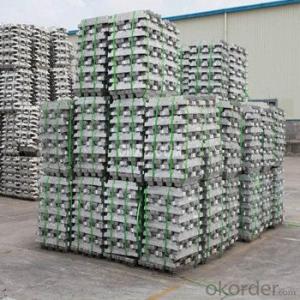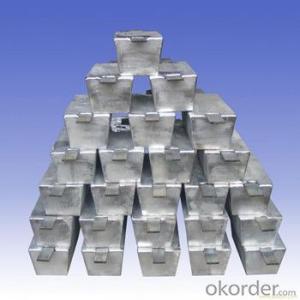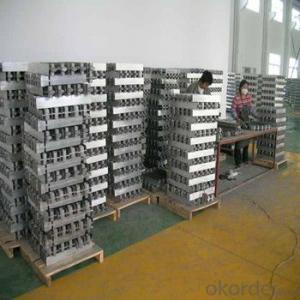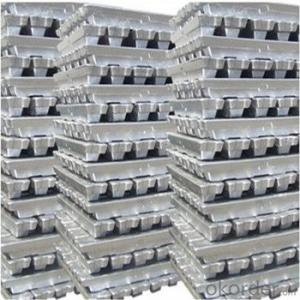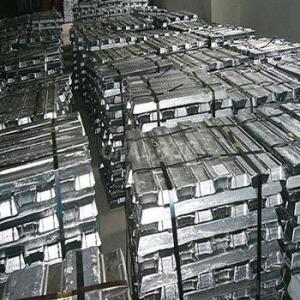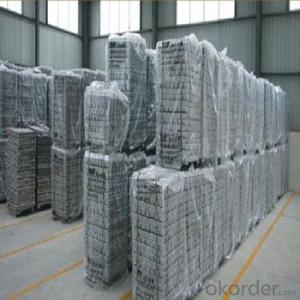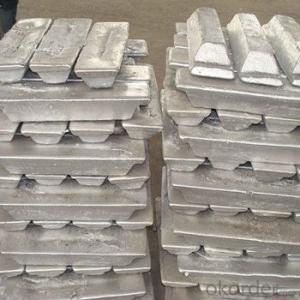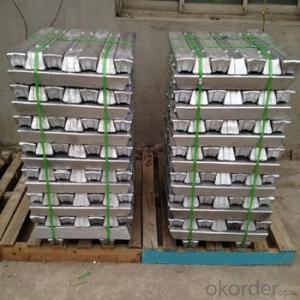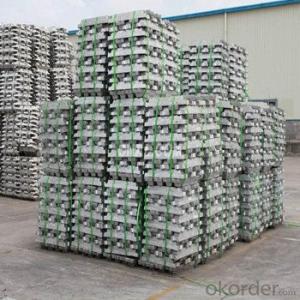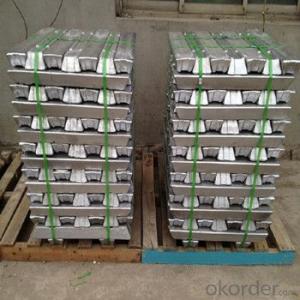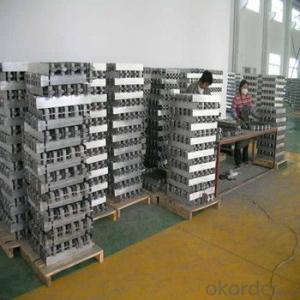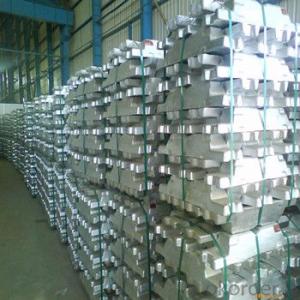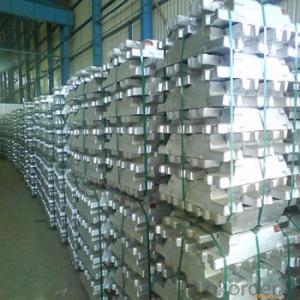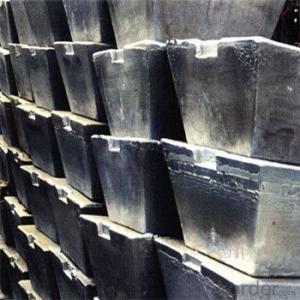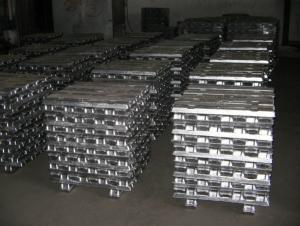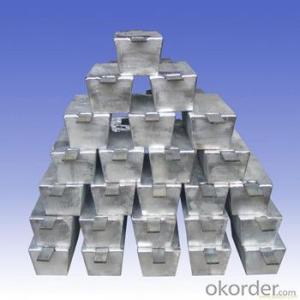Aluminum Ingot 99.9% with Best Price and High Purity
- Loading Port:
- China main port
- Payment Terms:
- TT OR LC
- Min Order Qty:
- 1000 m.t.
- Supply Capability:
- 10000 m.t./month
OKorder Service Pledge
OKorder Financial Service
You Might Also Like
Pure Aluminum Ingot Used for Industry
1.Structure of Aluminum Ingot Description
Aluminum Ingot is with the AL as the main chemical composition. Aluminum Ingot is used for industry,such as automobile,pinning and weaving,electron broadly and so on. Aluminum Ingot has the following advantages: easy control and operation, fast melting.
2.Main Features of the Aluminum Ingot
•High Purity
•Easy control and operation
•High strength
•Fast melting
•Competitive price
•Best Service
3. Aluminum Ingot Images

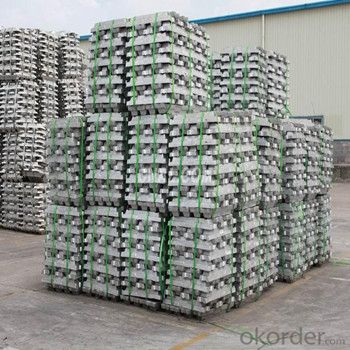
4. Aluminum Ingot Specification
Grade | Chemical Composition % | |||||||||
Al≥ | impurities ≤ | |||||||||
Si | Fe | Cu | Ga | Mg | Zn | Mn | others | Sum | ||
Al99.9 | 99.90 | 0.50 | 0.07 | 0.005 | 0.02 | 0.01 | 0.025 | - | 0.010 | 0.10 |
Al99.85 | 99.85 | 0.80 | 0.12 | 0.005 | 0.03 | 0.02 | 0.030 | - | 0.015 | 0.15 |
Al99.7 | 99.70 | 0.10 | 0.20 | 0.010 | 0.03 | 0.02 | 0.030 | - | 0.030 | 0.30 |
Al99.6 | 99.60 | 0.16 | 0.25 | 0.010 | 0.03 | 0.03 | 0.030 | - | 0.030 | 0.40 |
Al99.5 | 99.50 | 0.22 | 0.30 | 0.020 | 0.03 | 0.05 | 0.050 | - | 0.030 | 0.50 |
Al99.00 | 99.00 | 0.42 | 0.50 | 0.020 | 0.03 | 0.05 | 0.050 | - | 0.050 | 1.00 |
5.FAQ of Aluminum Ingot
We have organized several common questions for our clients,may help you sincerely:
①How about your company?
A world class manufacturer & supplier of castings forging in carbon steel and alloy steel,is one of the large-scale professional investment casting production bases in China,consisting of both casting foundry forging and machining factory. Annually more than 8000 tons Precision casting and forging parts are exported to markets in Europe,America and Japan. OEM casting and forging service available according to customer’s requirements.
②How to guarantee the quality of the products?
We have established the international advanced quality management system,every link from raw material to final product we have strict quality test;We resolutely put an end to unqualified products flowing into the market. At the same time, we will provide necessary follow-up service assurance.
③How long can we receive the product after purchase?
In the purchase of product within three working days, We will arrange the factory delivery as soon as possible. The pecific time of receiving is related to the state and position of customers.Commonly 7 to 10 working days can be served.
- Q: How much capital do I need to invest in the recycled aluminium ingot?
- There's no coke left now, too often. Are the basic carbon, and Shanxi coal, coal and bituminous coal is not done, too complex that do come in, now the industry is difficult to do, but it is not a hurry, hurry when. And they have to pay for it like a grandchild.
- Q: How much is a ton of aluminium ingots?
- If the die cast aluminum ingots, such as ADC12, are more expensive
- Q: How are aluminum ingots used in the production of modular buildings?
- Aluminum ingots play a crucial role in the production of modular buildings due to their unique characteristics and properties. These ingots are first melted and then transformed into various components, such as beams, columns, panels, and other structural elements, that are used to construct the modular units. One of the main advantages of aluminum is its lightweight nature, making it an ideal choice for modular construction. Aluminum ingots are much lighter than steel, yet they offer excellent strength-to-weight ratio, ensuring the durability and stability of the modular building. This lightweight characteristic also allows for easier transportation and assembly of the modules, reducing the overall construction time and costs. Moreover, aluminum offers exceptional corrosion resistance, which is particularly beneficial for modular buildings that may be exposed to harsh weather conditions or coastal environments. This resistance to corrosion ensures that the building will maintain its structural integrity and aesthetics for a longer period of time, reducing maintenance and repair costs. Aluminum ingots are also highly versatile and can be easily molded and shaped into various forms and sizes. This flexibility allows architects and designers to create innovative and customized modular building designs, meeting different functional and aesthetic requirements. Additionally, aluminum can be easily recycled, making it a sustainable choice for modular construction projects, aligning with the growing demand for environmentally friendly and energy-efficient buildings. In conclusion, aluminum ingots are used in the production of modular buildings due to their lightweight, corrosion-resistant, versatile, and sustainable properties. These ingots are transformed into various components that provide strength, durability, and flexibility to the modular units, facilitating faster construction, reducing costs, and ensuring long-term performance.
- Q: How does the ADC12 die casting aluminium ingot contain copper?
- If the amount of Cu is not too high, you can try to buy some A00 aluminum ingots to reduce the content of Cu, but after adding A00 aluminum, other chemicals will also be reduced, but as long as the main ingredients in the range, there will be no problem
- Q: Now refining aluminum ingot profits? What are the main factories?
- The main fuel of the pot for coke, coal and coal, the effect is not good, the process is very simple, is to put the cans back into the pot melting aluminum water, with a spoon to scoop out the mold to cast into ingots, the need to pay attention to is because cans belongs to the thin material industry often said, it is easy to burn, the best the method is the first of the aluminum water in the pot, and then put the cans or pressed into blocks and then cast.
- Q: How are aluminum ingots used in the production of building facades?
- Aluminum ingots are commonly used in the production of building facades as they serve as the raw material for the manufacturing of aluminum panels or cladding. These ingots are melted down and then extruded or rolled into thin sheets, which are then cut, shaped, and installed to create the outer layer of a building's façade. Aluminum's lightweight, corrosion-resistant, and malleable properties make it an ideal choice for building facades, providing durability, aesthetic appeal, and energy efficiency to the structure.
- Q: What is the difference between aluminium ingot YL112 and YLD112?
- YLD102 is the 102 grade aluminum die casting forging, die casting aluminum YL102 is 102 grade, three digits behind the first said alloy series, 1 aluminum silicon alloy, 2 aluminum copper alloy, 3 aluminum magnesium alloy, 4 aluminum zinc alloy and so on, after the two representatives of the serial number,
- Q: What elements do alloy die casting ingots require?
- Silicon is the major element in most die cast aluminum alloys. It can improve the casting properties of alloys. Silicon and aluminum can form solid solutions. At 577 DEG C, the solubility of silicon in aluminium is 1.65%, at room temperature is 0.2%, and when silicon content is up to 11.7%, silicon and aluminum form eutectic. Improve the high temperature molding properties of the alloy, reduce shrinkage, no hot cracking tendency. Two element aluminum base alloy has high corrosion resistance. When the content of silicon in the alloy exceeds the eutectic component, and the impurities such as copper and iron are long, the hard point of free silicon appears, which makes the machining difficult. The corrosion of the cast silicon crucible by high silicon aluminum alloy is serious.
- Q: How can aluminum cans be made into aluminium ingots?
- First combustion in pure oxygen to produce three aluminum oxide two, and then three oxidation of two aluminum and iron combustion in the air replacement, the formation of iron oxide substances and aluminum elements, which is the required - aluminum ingot
- Q: How are aluminum ingots used in the production of power transmission towers?
- Aluminum ingots are used in the production of power transmission towers as a key material for constructing the tower structure. They are melted and cast into specific shapes to form the tower components, such as the main support columns, cross arms, and braces. Aluminum's lightweight yet strong properties make it an ideal choice for these applications, enabling the towers to efficiently support the transmission lines while minimizing the overall weight and cost of the structure.
Send your message to us
Aluminum Ingot 99.9% with Best Price and High Purity
- Loading Port:
- China main port
- Payment Terms:
- TT OR LC
- Min Order Qty:
- 1000 m.t.
- Supply Capability:
- 10000 m.t./month
OKorder Service Pledge
OKorder Financial Service
Similar products
Hot products
Hot Searches
Related keywords
